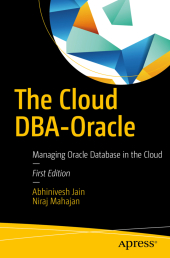 Neuerscheinungen 2017Stand: 2020-02-01 |
Schnellsuche
ISBN/Stichwort/Autor
|
Herderstraße 10
10625 Berlin
Tel.: 030 315 714 16
Fax 030 315 714 14
info@buchspektrum.de |

Abhinivesh Jain, Niraj Mahajan
(Beteiligte)
The Cloud DBA-Oracle
Managing Oracle Database in the Cloud
1st ed. 2017. xxi, 218 S. 6 SW-Abb., 231 Farbabb. 235 mm
Verlag/Jahr: SPRINGER, BERLIN; APRESS 2017
ISBN: 1-484-22634-8 (1484226348)
Neue ISBN: 978-1-484-22634-6 (9781484226346)
Preis und Lieferzeit: Bitte klicken
Learn how to define strategies for cloud adoption of your Oracle database landscape. Understand private cloud, public cloud, and hybrid cloud computing in order to successfully design and manage databases in the cloud.
The Cloud DBA-Oracle provides an overview of Database-as-a-Service (DBaaS) that you can use in defining your cloud adoption strategy. In-depth details of various cloud service providers for Oracle database are given, including Oracle Cloud and Amazon Web Services (AWS). Database administration techniques relevant to hosting databases in the cloud are shown in the book as well as the technical details needed to perform all database administration tasks and activities, such as migration to the cloud, backup in the cloud, and new database setup in the cloud.
You will learn from real-world business cases and practical examples of administration of Oracle database in the cloud, highlighting the challenges faced and solutions implemented.
What you will learn:
Cloud computing concepts from the DBA perspective, such as private cloud, public cloud, hybrid cloud
Technical details of all aspects of cloud database administration
Challenges faced during setup of databases in private cloud or database migration to public cloud
Key points to be kept in mind during database administration in the cloud
Practical examples of successful Oracle database cloud migration and support
Who Is This Book For
All levels of IT professionals, from executives responsible for determining database strategies to database administrators and database architects who manage and design databases.
PART I: Cloud Computing Fundamentals
CHAPTER 1: Introduction to Cloud computing
Definition
Benefits
Challenges
Service Models
Cloud Deployment Models
Metering and Chargeback
Summary
CHAPTER 2: Introduction to Database as a service
What is Database as a service (DBaaS)
DBaaS Public cloud offerings
DBaaS in Private cloud
DBaaS in managed services model
Getting Started with DBaaS
Getting acquainted with Basic terminalogies in DBaaS
Summary
PART II: Database Administration in Cloud
CHAPTER 3: Provisioning 2
Database Provisioning Overview
Database Provisioning in Oracle Cloud
Database Provisioning in AWS
Summary
CHAPTER 4: High Availability Options
Need of High Availability for Cloud based DB
Database High Availability overview
HA options in Oracle cloud
HA options in AWS
Summary
CHAPTER 5: Diaster
Recovery Options
Need of Disaster Recovery for cloud based DB
Diaster Recovery overview
DR options in Oracle Cloud
Provisioning of DataGuard in Oracle Cloud
DataGuard administration in Oracle Cloud
DR options in AWS
Summary
CHAPTER 6: DB Security
Need of Database security for cloud based DB
Cloud Security model
Security configurations in Oracle cloud
Security configurations in AWS
Security Best Practices
Summary
CHAPTER 7: DB Migration to Cloud
DB Migration Overview
DB Migration Key considerations
Migration lifecycle
Migration approach
Migration Options
Migration from local DB to Amazon RDS
Migration using Oracle Data pump
Migration using RMAN backup restore
Migration using cloning a PDB into Cloud
Migration using DMS
Migration using AWS Snowball
Migration Best Practices
Summary
CHAPTER 8: Backup and Restore
Overview of database backup and restore from cloud perspective
DB backup and restore in Oracle cloud
Database recovery in Oracle cloud
DB backup and restore in AWS
Backup and restore best practices
Summary
CHAPTER 9: Manage and Monitor
Overview of Cloud DB monitoring and Management
DB monitoring and Management in Oracle cloud
DB monitoring and Management in AWS
DB monitoring and Management Best Practices
Summary


